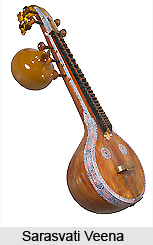 Sarasvati Veena, as the South Indian Veena is also known, is a string musical instrument. Historically, the development of this instrument is quite difficult to trace. However, it is quite possible that the Sarasvati Veena is a highly modified form of the Nanduruni which is seen even today in the south Indian state of Kerala. Traditionally, however, it is supposed that the Sarasvati Veena was the creation of the king Raghunath Nayak of Thanjavur (seventeenth century). The Sarasvati Veena is said to be the abode of divinity as the Veena Danda represents Lord Shiva, the strings Parvati, the dragon head Lord Vishnu, the bridge Goddess Lakshmi, the balancing gourd Lord Brahma and the connecting metal cone Goddess Saraswati.
Sarasvati Veena, as the South Indian Veena is also known, is a string musical instrument. Historically, the development of this instrument is quite difficult to trace. However, it is quite possible that the Sarasvati Veena is a highly modified form of the Nanduruni which is seen even today in the south Indian state of Kerala. Traditionally, however, it is supposed that the Sarasvati Veena was the creation of the king Raghunath Nayak of Thanjavur (seventeenth century). The Sarasvati Veena is said to be the abode of divinity as the Veena Danda represents Lord Shiva, the strings Parvati, the dragon head Lord Vishnu, the bridge Goddess Lakshmi, the balancing gourd Lord Brahma and the connecting metal cone Goddess Saraswati.
Structure of Sarasvati Veena
The instrument consists of a bowl, neck and the fingerboard. In Veenas of high quality all the three are scooped out of one log of wood, usually jackwood, and hence known as Ekanda Veena. But in ordinary lutes, they are separately made and joined. The fingerboard (Dandi) is long like a shallow gutter, with a curved bottom. The bowl (Kudam), the neck and the Dandi are all covered with a flat wood. The covering on the resonator usually has two sound holes. The wooden bridge (Kudirai, meaning a horse), which is wide and covered on the top with a thin lamina of brass, stands at the centre of the Kudam. Besides this main bridge and attached to it there is also an auxiliary metallic one onto a side. Four strings, tuned to Sa, Pa, Sa, Pa pass over the principal bridge; one end of each string is fixed to a thick wire of steel, called the Langar, which in its turn is attached to a metallic frame at the end of the bowl. The other end of the string passes over a ledge onto a peg. Over the auxiliary bridge run three strings, the Sarani, tuned to Sa, Pa. Sa1. These also have Langars and are stretched from the lower end of the bowl to special pegs at the side.
Playing of Sarasvati Veena
While gross tuning is done by turning the pegs, finer tuning is achieved by moving up or down a small metal coil on the Langar. It is only on the four main strings that melody is played, the right fore and middle fingers being used for plucking and the left fingers for pressing the strings against the frets. The Sarani strings, flicked by the right little finger give the drone and the Tala. There is a special way of fixing the frets which, unlike in the Sitar and the Rudra Veena are neither concave nor sharp edged. They are straight, fairly flat and wide. Further they are embedded in a layer of wax applied to two ledges on the fingerboard, so that they stand out fairly high. The Dandi itself ends in a peg box which culminates in an animal head, the Yali; there is an additional gourd resonator below the Dandi at this end. In current practice, the Veena is held almost horizontally, the main resonator resting on the ground and the gourd on the thigh.




